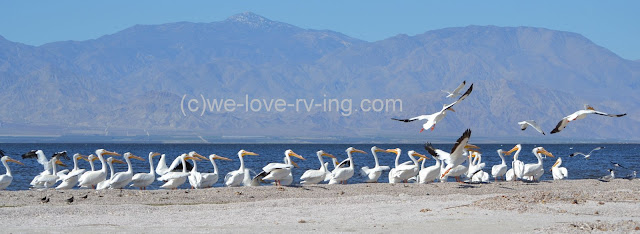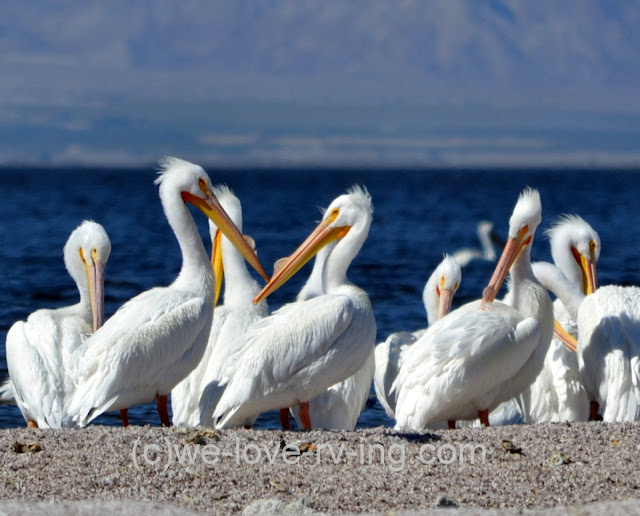The Salton Sea is one of the world’s largest inland seas and at 69m (227 ft) below sea level is also one of the lowest places on earth. 35 miles long and 15 miles wide, the Salton is located just south of Palm Springs on Hwy 111 and considered one of the world’s most vital avian habitats so that sounds to me, like a great place to take my camera.
 |
| The Salton Sea, California |
History of the sea goes back zillions of years but it became a barren dry bed until a temporary diversion of the Colorado River caused flooding and began filling it in 1905. They began finding breeding colonies of several birds and the rest is history. The water comes in through 3 rivers which all contain levels of salt but water evaporates leaving behind the salt, which with such high levels now does cause problems. For more on that, click here.
 |
| An egret on the Salton Sea, CA |
We are here to see the birds and there are plenty of birds to see, some of them slightly different from those we are familiar with, others are very different.
I love to see birds as long as they keep their distance and not get too close to me and I think they feel the same way.
A great zoom lens is going to be my favorite accessory today!
 |
| Yellow footed gulls on Salton Sea, CA |
We’ve visited the Salton Sea State Park in the past and had seen many gulls but it wasn’t until I began reading my info that I realized that these gulls are not the same as our Western gulls back home but are a yellow footed gull and this is the only area in the U.S. where you will find them. Now that makes them special. These gulls, with a population of 60,000 are slightly larger than the Western gull with a wing span up to 140-160cm (55”-63”) and I’m sure we saw most of them here today.
 |
| A Snowy Egret overlooks the fish in Salton Sea. |
The Snowy Egret can usually be found at the Salton Sea and we often see one in our RV park when he stops to visit the pond. They get a green neon patch on their face and the long plume on their back for breeding season and it was due to the plumes that the Snowy Egret almost became extinct. In the days previous to the late nineteenth century, the plumes were used for ladies hats and this had to be stopped to save these beautiful birds.
 |
| Four Great Blue Herons at Salton Sea State Park, CA |
The Great Blue Heron can usually be seen any season of the year and they nest here in the springtime. They are the largest of the herons of North America with a wingspan up to 2m (6.6’) and stand almost as tall as a 6’ person. They can live in saltwater and fresh water, open coasts, marshes, riverbanks and even backyard fish ponds and we’ve seen that happen while visiting friends in Lake Arrowhead, CA.
 |
| Snowcapped mountains surround the Salton Sea, CA |
I had read that pelicans are among the thousands of birds that flock to the
Salton Sea so I am anxious to see some of them on our adventure of the day.
We had seen both brown and white pelicans on our travels on the
Texas waterfront a few years ago and have seen a few white ones as they’d passed through
Kamloops, BC but I was hoping to see a lot more of them today.
 |
| Flock of White Pelicans at the Salton Sea, CA |
I was not disappointed in my pelican search! What was a white mass of birds way down on a secluded part of the beach turned out to be a flock of Great White Pelicans. I stayed far enough off the water’s edge behind some shrubs so as not to disturb them as I made my way down there, found myself a good hiding spot and took 160 photos within minutes. To say I was excited would be an understatement!
 |
| White pelicans with all eyes right! |
Up to 80% of the White pelican population has been seen on the
Salton Sea.
These pelicans are the second largest bird, (the largest is the California Candor) and have a wing span of 240-300 cm (95”-120”), now that is a huge bird.
I was thankful to have a good zoom lens which meant I could stay quite a long way away from these beauties.
 |
| Pelican coming in for a landing on the Salton Sea, CA |
The pelicans look all white but they have the black tips on the wings which show when they fly, and I was able to get some in flight in those 160 photos, loving that zoom lens. (:
I sure don’t want to be anywhere near flying birds, let alone really big ones, but they seemed oblivious to me, and were staying on the water’s edge on this windy day.
 |
| The beaks are getting brighter |
The white pelicans bill, eyes and feet all turn a brighter orange color during breeding time then those colors fade out afterwards. They also have a ‘horn’ on their upperbill that will fall off after they breed and lay their eggs. There are differences in the colors of these pelican’s bills in the photos, some are brighter than others as breeding time is coming.
 |
| Feathers on these pelicans are bright white |
Their feathers are a beautiful bright white at this time of year but that will change a bit after breeding time and the breast feathers become a bit yellowed.
That doesn’t happen till May or June so I am disappointed we won’t be here to see the babies that will come from this flock.
They'll be all grown up before we see them next year.
 |
| White Pelicans on the beach of the Salton Sea, CA |
I had a difficult time choosing only a few photos to share of all that I had taken but those White Pelicans do all look alike.
I only hope I was able to show what an incredible sight this actually was, one I shall not forget.
Blue sky, sunshine and pelicans! What a wonderful way to spend some time at the beach!












No comments:
Post a Comment